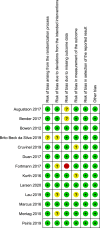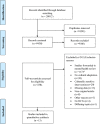Culturally adapting internet- and mobile-based health promotion interventions might not be worth the effort: a systematic review and meta-analysis
- PMID: 35322172
- PMCID: PMC8943001
- DOI: 10.1038/s41746-022-00569-x
Culturally adapting internet- and mobile-based health promotion interventions might not be worth the effort: a systematic review and meta-analysis
Abstract
Health promotion interventions offer great potential in advocating a healthy lifestyle and the prevention of diseases. Some barriers to communicating health promotion to people of certain cultural groups might be overcome via the internet- and mobile-based interventions (IMI). This systematic review and meta-analysis aims to explore the effectiveness of culturally adapted IMI for health promotion interventions among culturally diverse populations. We systematically searched on Cochrane Central Register of Controlled Trials (CENTRAL), EbscoHost/MEDLINE, Ovid/Embase, EbscoHost/PsychINFO, and Web of Science databases in October 2020. Out of 9438 records, 13 randomized controlled trials (RCT) investigating culturally adapted health promotion IMI addressing healthy eating, physical activity, alcohol consumption, sexual health behavior, and smoking cessation included. From the included studies 10,747 participants were eligible. Culturally adapted IMI proved to be non-superior over active control conditions in short- (g = 0.10, [95% CI -0.19 to 0.40]) and long-term (g = 0.20, [95% CI -0.11 to 0.51]) in promoting health behavior. However, culturally adapted IMI for physical activity (k = 3, N = 296) compared to active controls yielded a beneficial effect in long-term (g = 0.48, [95%CI 0.25 to 0.71]). Adapting health promotion IMI to the cultural context of different cultural populations seems not yet to be recommendable given the substantial adaption efforts necessary and the mostly non-significant findings. However, these findings need to be seen as preliminary given the limited number of included trials with varying methodological rigor and the partly substantial between-trial heterogeneity pointing in the direction of potentially useful culturally adapted IMI which now need to be disentangled from the less promising approaches.PROSPERO registration number: 42020152939.
© 2022. The Author(s).
Conflict of interest statement
The authors declare that the research was conducted in the absence of any commercial or financial relationships that could be construed as a potential conflict of interest.
Figures








Similar articles
-
Protocol for a systematic review and meta-analysis of culturally adapted internet- and mobile-based health promotion interventions.BMJ Open. 2020 Nov 9;10(11):e037698. doi: 10.1136/bmjopen-2020-037698. BMJ Open. 2020. PMID: 33168550 Free PMC article.
-
Cultural adaptation of internet- and mobile-based interventions for mental disorders: a systematic review.NPJ Digit Med. 2021 Aug 25;4(1):128. doi: 10.1038/s41746-021-00498-1. NPJ Digit Med. 2021. PMID: 34433875 Free PMC article. Review.
-
Adapting health promotion interventions to meet the needs of ethnic minority groups: mixed-methods evidence synthesis.Health Technol Assess. 2012;16(44):1-469. doi: 10.3310/hta16440. Health Technol Assess. 2012. PMID: 23158845 Free PMC article. Review.
-
Effectiveness of culturally tailoring smoking cessation interventions for reducing or quitting combustible tobacco: A systematic review and meta-analyses.Addiction. 2024 Apr;119(4):629-648. doi: 10.1111/add.16400. Epub 2023 Dec 17. Addiction. 2024. PMID: 38105395
-
The future of Cochrane Neonatal.Early Hum Dev. 2020 Nov;150:105191. doi: 10.1016/j.earlhumdev.2020.105191. Epub 2020 Sep 12. Early Hum Dev. 2020. PMID: 33036834
Cited by
-
Preliminary Feasibility and Acceptability of a Culturally Specific Intervention for Reducing Sexual Revictimization of College Women.J Stud Alcohol Drugs. 2025 Mar;86(2):306-315. doi: 10.15288/jsad.24-00024. Epub 2025 Feb 3. J Stud Alcohol Drugs. 2025. PMID: 39895635 Clinical Trial.
-
Cultural adaptation of a digital therapeutic for insomnia for Spanish-speaking Hispanic adults in the United States: a qualitative study.Lancet Reg Health Am. 2025 Jul 1;48:101158. doi: 10.1016/j.lana.2025.101158. eCollection 2025 Aug. Lancet Reg Health Am. 2025. PMID: 40688762 Free PMC article.
-
A modern web-based health promotion program for patients in Greece with diabetes 2 and obesity: an interventional study.BMC Public Health. 2023 Apr 3;23(1):639. doi: 10.1186/s12889-023-15557-3. BMC Public Health. 2023. PMID: 37013500 Free PMC article. Clinical Trial.
-
The Effect of an App-Based Multimodal Cancer Rehabilitation Programme on Sense of Coherence of Women With Gynaecological Cancer: Study Protocol for a Randomised Controlled Trial.Nurs Open. 2025 Jul;12(7):e70260. doi: 10.1002/nop2.70260. Nurs Open. 2025. PMID: 40579827 Free PMC article.
-
An Online Mindfulness Intervention for International Students: A Randomized Controlled Feasibility Trial.Clin Psychol Eur. 2023 Jun 29;5(2):e9341. doi: 10.32872/cpe.9341. eCollection 2023 Jun. Clin Psychol Eur. 2023. PMID: 37732147 Free PMC article.
References
-
- Cerf ME. Healthy lifestyles and noncommunicable diseases: nutrition, the life‐course, and health promotion. Lifestyle Med. 2021;2:1–12.
-
- World Health Organization. Sexual Health and its Linkages to Reproductive Health: an Operational Approach 1–12 (World Health Organization, 2017).
-
- Di Cesare M, et al. Inequalities in non-communicable diseases and effective responses. Lancet. 2013;381:585–597. - PubMed
Publication types
LinkOut - more resources
Full Text Sources

